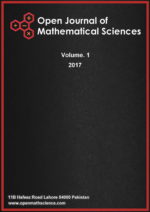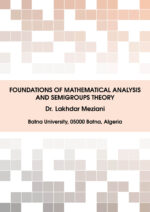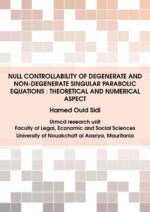Ptolemy Scientific Research Press (PSR Press)is a highly regarded publisher of scientific literature dedicated to bringing the latest research and findings to a broader audience. With a focus on cutting-edge research and technology, Ptolemy Scientific Research Press offers a range of publications catering to professionals, researchers, and student’s needs. Whether looking for information on the latest breakthroughs in physics, biology, engineering, or computer science, you can trust Ptolemy Scientific Research Press to deliver insightful, accurate, and engaging content. With its commitment to quality, accessibility, and innovation, Ptolemy Scientific Research Press is an essential resource for anyone interested in science and technology.

Latest Published Articles
EASL-Vol. 2 (2019), Issue 4, pp. 33 – 44 Open Access Full-Text PDF
B. Y. Ogunmola, A. A. Yinusa
Abstract: The penetration of fuel spray as a result of the mixture of fuel droplet and entrained air usually generate nonlinear models whose solutions are normally difficult to realize analytically. This present study presents general approximate analytical solution to such problem by employing Differential transform Method (DTM). At the level of two-phase flow, the spray droplets and the entrained air have the same flow velocity. In order to fully understand the process, the parameters present in the governing equations are carefully studied. The obtained solution employing DTM is verified with Numerical Runge-Kutta (RKF45) and also compared with similar past works. Furthermore, the acquired results for different ambient densities and injection velocities are depicted and discussed. The results illustrate that continuous increase in the initial velocity and orifice diameter cause a corresponding increase in spray penetration while an antonymous effect is noticed for an increased semi cone angle and density. This work will find vital applications in the optimization of systems whose operation are influence by the aforementioned spray penetration processes.
Pseudo-valuations and pseudo-metric on JU-algebras
OMS-Vol. 3 (2019), Issue 1, pp. 440 – 446 Open Access Full-Text PDF
Usman Ali, Moin A. Ansari, Masood Ur Rehman
Abstract: In this paper we have introduced the concept of pseudo-valuations on JU-algebras and have investigated the relationship between pseudo-valuations and ideals of JU-algebras. Conditions for a real-valued function to be a pseudo-valuation on JU-algebras are given and results based on them have been shown. We have also defined and studied pseudo-metric on JU-algebras and have proved that \(\vartheta\) being a valuation on a JU-algebras \(A\), the operation \(\diamond\) in \(A\) is uniformly continuous.
Design, synthesis of spiro quinazolinone compacted with chitosan through DFT approach for interference the antimicrobial activity
OJC-Vol. 2 (2019), Issue 2, pp. 33 – 42 Open Access Full-Text PDF
Eman Abdel-Nasser, Jehan A. Hafez, Radwa M. Badawy, Hadeer I. Mohamed, Sameh A. Rizk
Abstract: In this work, we present a newly three antimicrobial chitosan, 2-benzoxazinyl benzoic acid (BBA) and novel biopolymer of Chitosan-spiroquinazolinone (SQC) via coupling of chitosan with benzoxazinyl benzoic acid, for promoting the antimicrobial activity of inherent chitosan. Modification in the chemical structure of the synthesized product SQC was confirmed using FT-IR and UV analysis. The antimicrobial activities of Chitosan, and BBA compounds were expressively increased more than chitosan-spiroquinazolinone SQC. Minimum inhibitory concentration (MIC) of compound SQC was supposed at \(50\mu g/ml\) against tested microorganisms except for B.cereus and C.albicans. The highest concentration of Chitosan would prevent the growth of Gram-+ve upto 99%. However, compound BBA recorded the maximum inhibition percentage versus Gram-+ve approximately 82%. The findings emphasized that the developed Chitosan-Spiroquinazolinone SQC may be blocker for antimicrobial activity to pure chitosan and BBA i.e, stop reaction if possible for actions of antimicrobial treatments.
Correlation between genotype and phenotype in adult primary open angle Glaucoma and mutations in myoc gene
OJC-Vol. 2 (2019), Issue 2, pp. 22 – 32 Open Access Full-Text PDF
Rabia Mushtaq, Rasheeda Bashir, Haniya Kalsoom, Shagufta Naz, Sadaf Naz, Maria Hasnain
Abstract: Glaucoma is a second leading cause of blindness worldwide and stands on fourth position among the cause of blindness. Two main types of Glaucoma, primary congenital Glaucoma (PCG) and primary open angle Glaucoma (POAG). Primary open angle Glaucoma is further classified in to primary juvenile open angle Glaucoma JOAG (age of onset 3-35 years) and adult onset open angle Glaucoma (after the age of 35 years). Myocilin (MYOC) gene plays a major role in the development of adult primary open angle Glaucoma (POAG). Mutations in Myocilin (MYOC) gene are well documented to cause Adult Primary Open Angle Glaucoma (POAG). Currently, very few data is available on the contribution of Myocilin (MYOC) gene in POAG in Pakistani population. In present study, fifty seven sporadic cases of autosomal recessive samples of Primary Open Angle Glaucoma (POAG) were collected from different hospitals of Lahore, Pakistan. Sequencing was performed to check the contribution of (MYOC) gene and to identify the common mutations present in Pakistani population. Sequencing results revealed previously reported one heterozygous synonymous single nucleotide polymorphism SNP and a variant in intronic exonic boundary of exon 2. Findings of this study revealed that contribution of (MYOC) gene is high. Therefore, there is need to enroll more patients and families to identify the pathogenic mutations in (MYOC) gene to report actual frequency of this gene and its mutations in our population. Mutations identified in this gene may be helpful at clinical level to diagnose the disease at early stages.
The stability analysis and control transmission of mathematical model for Ebola Virus
OMA-Vol. 3 (2019), Issue 2, pp. 91 – 102 Open Access Full-Text PDF
Muhammad Tahir, Gul Zaman, Syed Inayat Ali Shah, Sher Muhammad, Syed Asif Hussain, Mohammad Ishaq
Abstract: Mathematical modeling of infectious diseases has progressed dramatically over the past four decades and continues to flourish at the nexus of mathematics, epidemiology, and infectious diseases research. Now recognized as a valuable tool, mathematical models are being integrated into the public health decision-making process more than ever before. In this article, a mathematical model of Ebola virus which is named as SEIVR (susceptible, exposed, infected, vaccinated, recovered) model is considered. First, we formulate the model and present the basic properties of the proposed model. Then, basic reproductive number is obtained by using the next-generation matrix approach. Furthermore, the sensitivity analysis of \(R_0\) is also discussed, all the endemic equilibrium points related to the disease are derived, a condition to investigate all possible equilibria of the model in terms of the basic reproduction number is obtained. In last, numerical simulation is presented with and without vaccination or control for the proposed model.
On the vector Fourier multipliers for compact groups
OMS-Vol. 3 (2019), Issue 1, pp. 433 – 439 Open Access Full-Text PDF
Abudulaï Issa, Yaogan Mensah
Abstract: This paper studies some properties of the Fourier multiplier operators on a compact group when the underlying multiplication functions (the symbols) defined on the dual object take values in a Banach algebra. More precisely, boundedness properties for such Fourier multiplier operators for the space of Bochner strong integrable functions and for the (vector) \(p\)-Fourier spaces are investigated.








